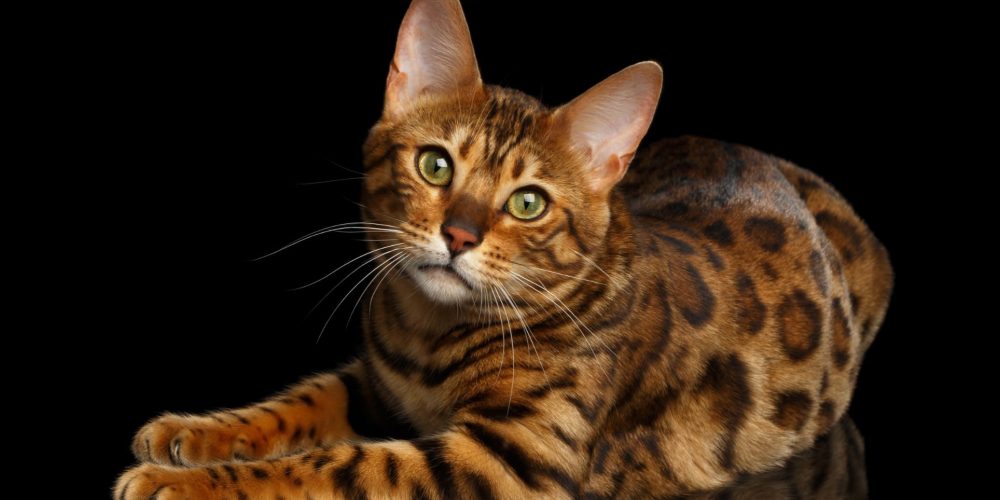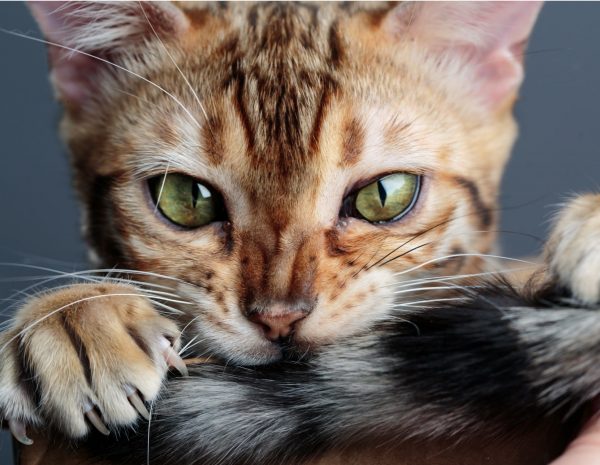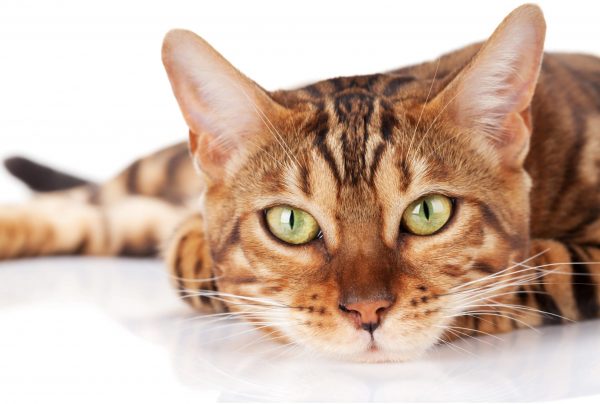Bengal

Types of Bengal Cats
In terms of exterior appearance, the Bengal breed is known for their exotic features and unusually beautiful coat patterns. Descended from the Asian Leopard Cat, Bengals are the perfect mixture of wild and tame.
Although a Bengal’s energy may be overwhelming to some owners, many people see them as fun, energetic companions.
Appearance
 The Bengal cat breed is famous for its striking appearance. From its strong yet graceful body to its alert, curious gaze, they are an intriguing breed. This energetic feline is known for their agility and calm, poised presence.
The Bengal cat breed is famous for its striking appearance. From its strong yet graceful body to its alert, curious gaze, they are an intriguing breed. This energetic feline is known for their agility and calm, poised presence.
They possess bright round eyes, wide noses, and dark facial markings resembling their wild ancestors. Their size ranges from medium to large, with males weighing up to 18 pounds and females weighing up to 12 pounds.
Regardless of their muscular build and elegant gait, the most fascinating feature about the these gorgeous cats is their ultra-plush, beautiful fur coat. Medium in length, their coat can feature a myriad of colors, patterns, and designs. The various colors that are intermixed in the fur reflect in sunlight, giving off the appearance of shimmering glitter.
Bengal Cat Lifespan
Although the Bengal cat is a generally healthy breed, there are certain conditions in which it is genetically predisposed. Given this, this breed has an average life expectancy between 14 and 16 years.
Bengal Cat Price
Similar to breeds like the Savannah cat, Bengals also have a generational system that determines how close or far the cat is from their Asian Leopard ancestor. (For example, an F1 Savannah cat is 50% wild, which means that the cat is just one generation removed from the African serval. The higher the filial number (F1, F2, F3), the further removed the cat is in generations from its wild ancestor.)
In terms of price, an F1 Bengal, which has an Asian Leopard cat as one parent and a domestic cat as the other parent, can go up to $10,000 in price. As the this stunning breed of cats become more genetically distant from their wild ancestor, the cheaper they become.
Bengal Cat Personality
 There is no doubt that the Bengal cat’s personality is reflective of its wild roots. These cats spend their days going on adventures that involve climbing, jumping, and exploring all the nooks or crannies it can get to.
There is no doubt that the Bengal cat’s personality is reflective of its wild roots. These cats spend their days going on adventures that involve climbing, jumping, and exploring all the nooks or crannies it can get to.
These cats have a sharp intuition and are often seen carefully assessing their surroundings, as if they were looking for prey.
If there are any activities going on, a Bengal wants to be part of it. Their high energy levels make them fun playmates and good sports.
Care should be taken, however, in making sure the beautiful felines have plenty of toys and games to keep it preoccupied. Bengal house cats are known to get into trouble if left unoccupied for too long.
It is recommended that puzzle games or a cat tree be purchased to foster its love for investigating and climbing.
Overall, the Bengal is a fun, loving companion that will always be up for adventure and excitement with its owner.
Bengal Cat Types
In reference to their coat appearance as a distinguishing factor, there are several unique types of Bengal cat. In general, this breed can come in either the spotted or marbled pattern with a wide array of color variations. Colors that are shades of bright orange and brown are most commonly seen.
Interestingly, depending upon their coat color, these amazing felines can also possess many beautifully distinct eye colors. Blue, green, hazel and gold are seen uniformly or as a combination in Bengal eye colors.
In terms of coat color, there are only 3 that are officially recognized:
- Brown
- Silver
- Snow (can be further subdivided into Snow Sepia, Snow Mink, and Snow Lynx)
The snow Bengal cats are usually light in color with darker spots or marbling all over. There are also Bengals seen with black, charcoal, and blue fur. However, these coat colors are not officially recognized.
Some cats within this breed feature a Bengal tabby mix.
Nearly all cats belonging to this breed possess dark-tipped tails, pink noses, and brown or black markings.
Bengal Cat Rescues
 Every day, this desirable cat is put up for adoption across the country. Like any animal, these Bengals long for a place to call home and a family to love them. If a prospective cat owner is interested in the breed, there are many reputable, amazing shelters that offer these cats.
Every day, this desirable cat is put up for adoption across the country. Like any animal, these Bengals long for a place to call home and a family to love them. If a prospective cat owner is interested in the breed, there are many reputable, amazing shelters that offer these cats.
Below are listed sites that feature directories of Bengal cat rescue sites where this breed can be found in different states.
- Adoptapet.com
- California Bengal Rescue
- Pet Adoptions by Overstock
- Wild N Sweet Bengals
- Great Lakes Bengal Rescue
These, along with many others, are great resources to begin the journey to adopting the perfect Bengal domestic cat. While individual shelter sites are incredible in and of themselves, large directories can help a potential owner look in specific states.
It is vital to remember to always choose a Bengal that has paperwork to back up its vaccinations and overall health status, especially if buying from a breeder.
Caring for Bengal Cats
Grooming
 Bengal owners are in luck. This breed is known to enjoy grooming itself and its shedding is very minimal. Besides a brief brush-over about once a week, this breed is low maintenance.
Bengal owners are in luck. This breed is known to enjoy grooming itself and its shedding is very minimal. Besides a brief brush-over about once a week, this breed is low maintenance.
Since shedding is minimal, they give off less dander, which can be problematic for those with severe allergies. Therefore, this feline is numbered among the small group of cats that are hypoallergenic.
Naturally, for people that deal with pet allergies year-round, a good choice of cat breed for them would be a this feline. Hypoallergenic cats give off considerably less dander, which means less allergies for those people prone to them.
Health Care
Bengal cats are predisposed to some specific, potentially serious health issues that owners should be aware of. To promote the best health in Bengal cats, early screenings, frequent vet check-ups, and noticing any unknown symptoms that may arise over time are all positive practices to utilize. In addition, providing core vaccinations (such as those for distemper and feline leukemia). Preventive medication for heartworm, fleas, and ticks should also be provided.
The most frequently diagnosed health conditions are those listed below:
- Distal neuropathy (condition of the nervous system; usually disappears as kitten ages)
- Flat-chested kitten syndrome (usually resolves as kitten ages)
- Progressive retinal atrophy (eye disease)
- Hip dysplasia (misalignment of hip joints)
- Patellar luxation (kneecap dislocation; hereditary)
People with Bengals should be well-aware of these common conditions. If any signs of one of these conditions is seen, the cat’s vet should be notified immediately. Check out more articles about how to keep your cat healthy and learn more about some of the best cat breeds.



